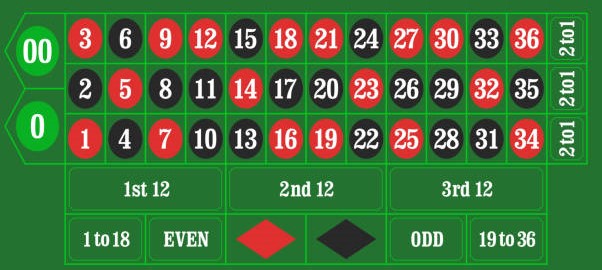
Martingale appears a compelling strategy to make money from the Roulette game. In the Martingale technique, you make an even-money (bottom row of the layout) bet. If successful, you win a unit profit (payoff is 1 to 1); end of the story. If you fail, you stay for another spin but double the wager, and you continue this pattern until you win. The argument is that if you play the game infinitely, the chances of repeated failure reach zero. That is a correct argument.
The opposite is also true – if you are on a losing track, withdrawing from the game or continuing on a reduced bet than required will result in losses. And that is what the casino will do. They put bet limits, say, at 500 dollars. That means, once your wager reaches above 500, you got to stay at 500, suggesting a loss of money even if you win from there onwards.
I will start the illustration with the first bet and win.
| Try | Bet | Outcome | Spent | Gained | Profit |
| 1 | 1 | WIN | 1 | 2 | 1 |
Imagine you lost the first spin, and as per Martingale strategy, you double the bet and continue at the same spot.
| Try | Bet | Outcome | Spent | Gained | Profit |
| 1 | 1 | FAIL | 1 | ||
| 2 | 2 | WIN | 3 | 4 | 1 |
This doubling bets each time appears like you double the potential profit also. But in reality, you exactly get the starting unit. Here is the illustration of winning after eight successive rounds of failure.
| Try | Bet | Outcome | Spent | Gained | Profit |
| 1 | 1 | FAIL | 1 | ||
| 2 | 2 | FAIL | 3 | ||
| 3 | 4 | FAIL | 7 | ||
| 4 | 8 | FAIL | 15 | ||
| 5 | 16 | FAIL | 31 | ||
| 6 | 32 | FAIL | 63 | ||
| 7 | 64 | FAIL | 127 | ||
| 8 | 128 | FAIL | 255 | ||
| 9 | 256 | WIN | 511 | 512 | 1 |
Once your doubling reaches above 500, you have to stay at 500, suggesting a loss of money even if you win from here onwards.
| Try | Bet | Outcome | Spent | Gained | Profit |
| 1 | 1 | FAIL | 1 | ||
| 2 | 2 | FAIL | 3 | ||
| 3 | 4 | FAIL | 7 | ||
| 4 | 8 | FAIL | 15 | ||
| 5 | 16 | FAIL | 31 | ||
| 6 | 32 | FAIL | 63 | ||
| 7 | 64 | FAIL | 127 | ||
| 8 | 128 | FAIL | 255 | ||
| 9 | 256 | FAIL | 511 | ||
| 10 | 500 | WIN | 1011 | 1000 | -11 |
You will argue that losing nine rounds in a row is highly unlikely. That is true; after all, the probability of staying on the losing course for nine spins is (20/38)9 = 0.3%.
That is why the motivation for playing the game is crucial. If it is for fun and making a dollar or two, this makes a perfect strategy. However, if you want to make money by this strategy, you will see the odds of getting nine successive fail is no smaller. Suppose the wheel spins 200 times the chance of nine failures in a row is one in three (see the earlier post for the calculations). The nightmare possibility can come on the 9th or the 600th.
The other argument is to start with more than 1 unit, as at the end of the day, one dollar starting bet will only get you 1 dollar as profit. Imagine you start with 5 dollars. The table is below.
| Try | Bet | Outcome | Spent | Gained | Profit |
| 1 | 5 | FAIL | 5 | ||
| 2 | 10 | FAIL | 15 | ||
| 3 | 20 | FAIL | 35 | ||
| 4 | 40 | FAIL | 75 | ||
| 5 | 80 | FAIL | 155 | ||
| 6 | 160 | FAIL | 315 | ||
| 7 | 320 | WIN | 635 | 640 | 5 |
The trouble with this is that you approach your ceiling in seven spins, and you lose 135 even if you win the 8th round. Now, the probability of getting seven consecutive fail in 200 games is almost certain (100%)! An extreme case is putting the first bet at 500. If you fail the first time, the game is no more any strategy, as you have only one chance to recover or lose 1000.
Martingale Strategy is Fun
It is a strategy to have fun, test your probability models and earn a few dollars but not get rich. The doubling of bets gives a feeling of doubling the profit, but we have seen that the final gain is always equal to the initial bet and higher the initial, you reach the ‘ceiling’ faster. If you continue the excitement after a few successes (1 or 2 dollars), the odds will hit you and take away everything.

